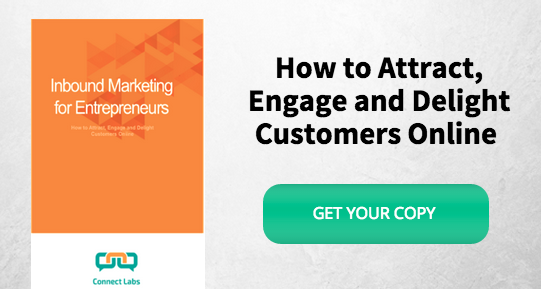You have done the hard work and people are coming to your website. But to grow your business you now need to get them to make a commitment and become a lead.
There are several things to consider in maximising your success in the conversion phase of the inbound marketing process.
What is inbound marketing?
Many startups are looking to inbound marketing as a way to effectively launch their products. This marketing process focuses on bringing customers to the business by providing relevant and interesting content. It is cost effective compared to traditional media, but also targeted, flexible and innovative - much like a startup itself.
“Instead of the old outbound marketing methods of buying ads, buying email lists, and praying for leads, inbound marketing focuses on creating quality content that pulls people toward your company and product, where they naturally want to be." HubSpot
The inbound marketing methodology is highlighted below:

Converting Visitors to Leads
So if the attraction phase has been executed correctly, we will have visitors to our website who are:
- Interested in the topic that we have been writing about; and
- It is in some way relevant to their needs.
The next step is to convert them to a lead who will potentially go on to make a purchase.
Generally speaking a lead is a prospect that has shown an interest in your product or service. In this process 'interest' has generally resulted in exchange - a personal or business contact detail (email address, name etc.) for a piece of information they are interested in (eBook, template etc).
There are several key elements that are required to ensure this exchange can occur:
- Call-To-Action: Clear buttons and links that provide the instructions for the visitors to continue their interest
- Landing Pages: Pages on the website that are dedicated to the offer that the visitor is interested in.
- Forms: This is the key mechanism of collecting the data from the visitor.
While all these elements are required to perform the functional exchange of key information, in our experience there is one key piece information that is missed. How do we maintain the relevancy and interest in our site and product? We have got them there so how do we get them to take the next step? The answer is to consider The Buyer's Journey.
The Buyer's Journey
The Buyer's Journey outlines three different stages in the buying cycle or buying decision that a visitor will go through:
Awareness Stage
Consideration Stage
Decision Stage
It stands to reason then, that if prospects are at different stages in their buying cycle, then the information that they require are also very different.
So for a business to remain relevant and interesting specific content needs to be developed for each stage. This content needs to consider:
- User behaviour: Have they identified symptoms of a problem, identified the problem or identified the solution?
- The research and information needs of the visitor: Are they looking for general information to understand the symptoms or are they comparing providers or gathering supporting document before closing the deal?
- Content Types: What is the most relevant type of content to solve their information needs?
- Keywords for action: What words will gel with the visitor and make them take action? For someone in the awareness phase resolve or upgrade may work whereas words such as 'comparisons' are more relevant to those in the decision phase.
Lets close with an example:
Entrepreneur X has developed their product and are now deciding what marketing is required to launch their product into the market place.
| AWARENESS | CONSIDERATION | DECISION | |
|---|---|---|---|
| PROBLEM | I have just got funding – how do I get it into the market? | Inbound is the way to go – where do I start? | Which automation product do I go with? |
| USER BEHAVIOUR | Have realised it is time to look at their marketing plan. | Have clearly defined and named their problem and solution is Inbound marketing. | Have defined their solution, method or approach. |
| RESEARCH & INFORMATION | Needs to understand how startups go to market, what are the options? | How does Inbound work? What do you need? What resources are required? | Product recommendations, endorsements. Data, bench marketing information to make a decision. |
| CONTENT TYPES | eBooks Whitepapers Editorial content Expert content Research Reports | Comparison white papers, Web case, Webinars Live interactions | Free Trial Live Demo Product Literature |
This example shows clearly that visitors in different stages need different information for them to continue their sales process. (Click here for another example). Utilising the buyer's journey will maintain the interest in the brand and product, while ensuring the content remains relevant to their needs. The result - more leads and more sales!
Find out more about the inbound marketing and how it can work for entrepreneurs and startups.

Tags:
Marketing + Automation
September 9, 2015
